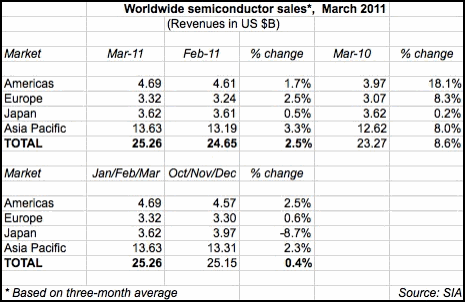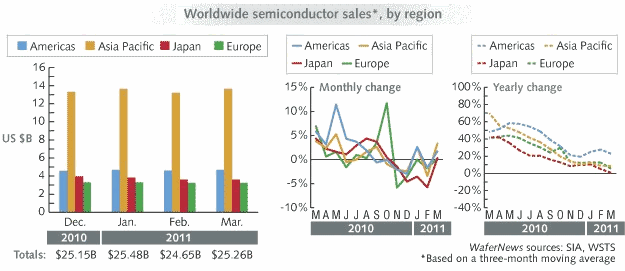May 3, 2011 – Global semiconductor sales inched up 2.5% in March to $25.3B, bringing 1Q11 chip sales up to scant 0.4% growth Q/Q at $75.8B (8.6% Y/Y), according to the SIA’s latest data. Y/Y percentages continue to drop; Japan is now flat (vs. 6% Y/Y in Feb.); Europe, Asia-Pacific, and Total are ~8% (vs. low-teens); and Americas is now 18% (vs. 26%).
SIA president Brian Toohey said the group is "very encouraged by the performance of the global and domestic semiconductor industry," which continues to be on pace to exceed US economic forecasts thanks to demand (both consumer and corporate) for electronics products and pervasiveness of technology in most industries.

The March data is the first to account for the Japanese earthquake + tsunami + nuclear disaster — but quick efforts to stabilize infrastructure and ongoing recovery efforts seem to have mitigated some of the impact on semiconductor markets, the SIA claims. In fact, Japan’s chip sector actually grew slightly for all of March vs. February, and improved its three-month rolling average from an -11% decline to -8.7%.
Interestingly, though, the SIA has recalculated its February numbers across the board, shaving about -2% overall to a revised $24.65B, or -$540M lower. Europe was spared a major revision (-$10M), but everyone else lost: Americas -1.5% ($70M), Japan -1.9% ($70M), and -2.9% ($390M) for the Asia-Pacific region excluding Japan. The SIA didn’t address the revision in its official statement. It’s not unusual for the SIA to tweak its monthly data due to reflect product align changes or data error during aggregation, but it’s rarely more than a point or two.
Acknowledging that "several major adjustments" were made, Ebun Caldeira, the SIA’s director of finance and market research, explained to SST that apparently some device suppliers (i.e., more than one), specifically in the MPU product segment, had originally sent in February data that appeared erroneously inflated. When the WSTS noticed and asked for clarification, it eventually received the restatements that lowered those figures; it’s unknown how those adjustments were balanced out among the suppliers. She stressed that the revised numbers were not tied to the Japanese situation. (It’s also possible, though purely speculation, that other factors and estimate adjustments could have exacerbated the problem.)

[Edit 5/3/2011: Changed some mentions of SIA to WSTS, which licenses its data to the SIA; the SIA doesn’t make revisions, the WSTS does. And reworded to eliminate any implication that suppliers’ "inflated" data was intentional.]

